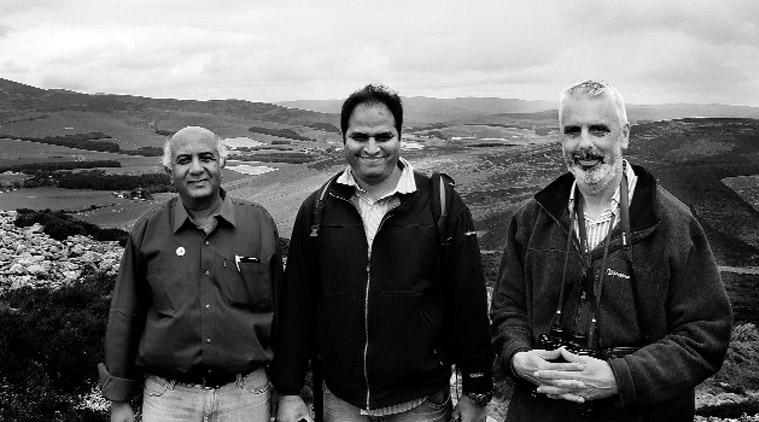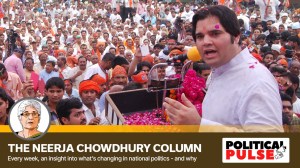- India
- International
The original forester
The life of Alexander Gibson, who implemented the first forest conservation programme in India, will soon be seen in a documentary.
 Dr Pande, Ghadge & Dr Noltie in Scotland for filming the documentary
Dr Pande, Ghadge & Dr Noltie in Scotland for filming the documentary
At noon, Dr Satish Pande checks his watch and asks the nurse at the sonography department of Pune’s KEM Hospital to send the last patient in. Within two hours, the 52-year-old radiologist will settle into what he calls “another role” — that of an ornithologist.
After 26 years of devoting equal time to medicine and his love of birds, Dr Pande recently took on a new project where he began to trace the life of Dr Alexander Gibson (1800-1867), the Scottish surgeon and botanist who has been credited as being the first in the world to systematically adopt a forest conservation programme based on scientific principles.
Dr Pande stumbled across Dr Gibson’s pathbreaking work in conserving forests in India when he set out to write a book on the history of Indian forests in 2013. “His valuable contribution, particularly in western India, has long been forgotten,” Dr Pande says. “I became interested in finding the details of his life because he, like me, was a doctor.”
Piece by piece, Dr Pande and another ornithologist, Kiran Ghadge, studied the work of Dr Gibson and brought it to the notice of the Forest Department. They explained the impact of Dr Gibson’s work to Dr Arvind Kumar Jha, the Director General, Social Forestry, who then gave them a grant to make a documentary on Dr Gibson’s life.
Dr Gibson first arrived in India as an East India Company surgeon in 1820 and learnt Hindi, Marathi and Gujarati. A linguist, he was already well-versed in Greek and Latin. In 1825, he left for Burma and returned in 1827. The British, who needed timber to build ships, realised there was a shortage of wood and thus deputed Dr Gibson to survey the Konkan forests. He went on to become the superintendent of Dapuri Botanical Gardens (1838-47) under the erstwhile Bombay Presidency. He submitted a report in 1843 and brought the need to protect forests to the notice of the East India Company, Dr Pande says.

“Dr Gibson travelled on horseback to complete his surveys. He was a man of iron constitution,” Dr Pande says. He even wrote two books on the state of the forests — Bombay Flora in 1861 and Handbook to the Forests of the Bombay Presidency in 1863.
Researching Dr Gibson’s life and work was not easy for the team. They retraced Dr Gibson’s steps and went from Pune’s Dapodi (earlier Dapuri) Botanic Garden to Hivre in Junnar taluka where he spent most of his time while in India, nurturing a garden where he grew medicinal, exotic and agriculturally important plants at an old forest bungalow. They also visited Dr Gibson’s two offices in Sadashivgad and Valsad.
Dr Pande says not even a single image of him exists in either India or Scotland, where Dr Gibson was born in 1800. This made it difficult to start filming a documentary, says Ghadge, who gave up a job at an IT firm to become a cinematographer.
“We contacted Dr H J Noltie, a botanist at the Royal Botanic Garden, Edinburgh, who wrote a biography on Dr Gibson 10 years ago. He had stayed in India for a month to research Dr Gibson’s life and his attempt to get photographs was also futile as even the Linnean Society of London, which had elected Gibson as a fellow, did not have an image,” Ghadge says.
Dr Pande and Ghadge then visited Gibson’s birthplace Kincardineshire in northeast Scotland and the Royal College of Surgeons in Edinburgh from where he got his licence to practise medicine. They even visited his grave and the Royal Botanical Garden at Kew in the UK. “Dr Gibson never married,” Ghadge says. “Based on his work, we imagine him to have been a strict disciplinarian and, thus, we drew up a character we believe resembles him.”
They filmed the letters Dr Gibson wrote to the director of the garden, Sir J D Hooker, who is also known as one of the founders of geographical botany. A letter written in 1841 described how “the Deccan is more bare than Gujarat’’ as the mountain trees in Ghats were disappearing fast. He requested Hooker to influence the government to help control the forests in the Deccan and Konkan region and this was recorded as the first case of state management of forests in the world.
The significance of Dr Gibson’s work in India was even highlighted in an obituary in the British Medical Journal in 1867 after his death. It read, “From the plains of Scinde to Cape Comorin, Alexander Gibson spent a quarter of a century conserving the forests of Western India.”
Dr Jha has now planned several events to highlight the impact of Dr Gibson’s work in India. “It is a lesson for our foresters to imbibe. Dr Gibson was a visionary who knew that forests have to be preserved,” Jha says.
Apr 24: Latest News
- 01
- 02
- 03
- 04
- 05







































